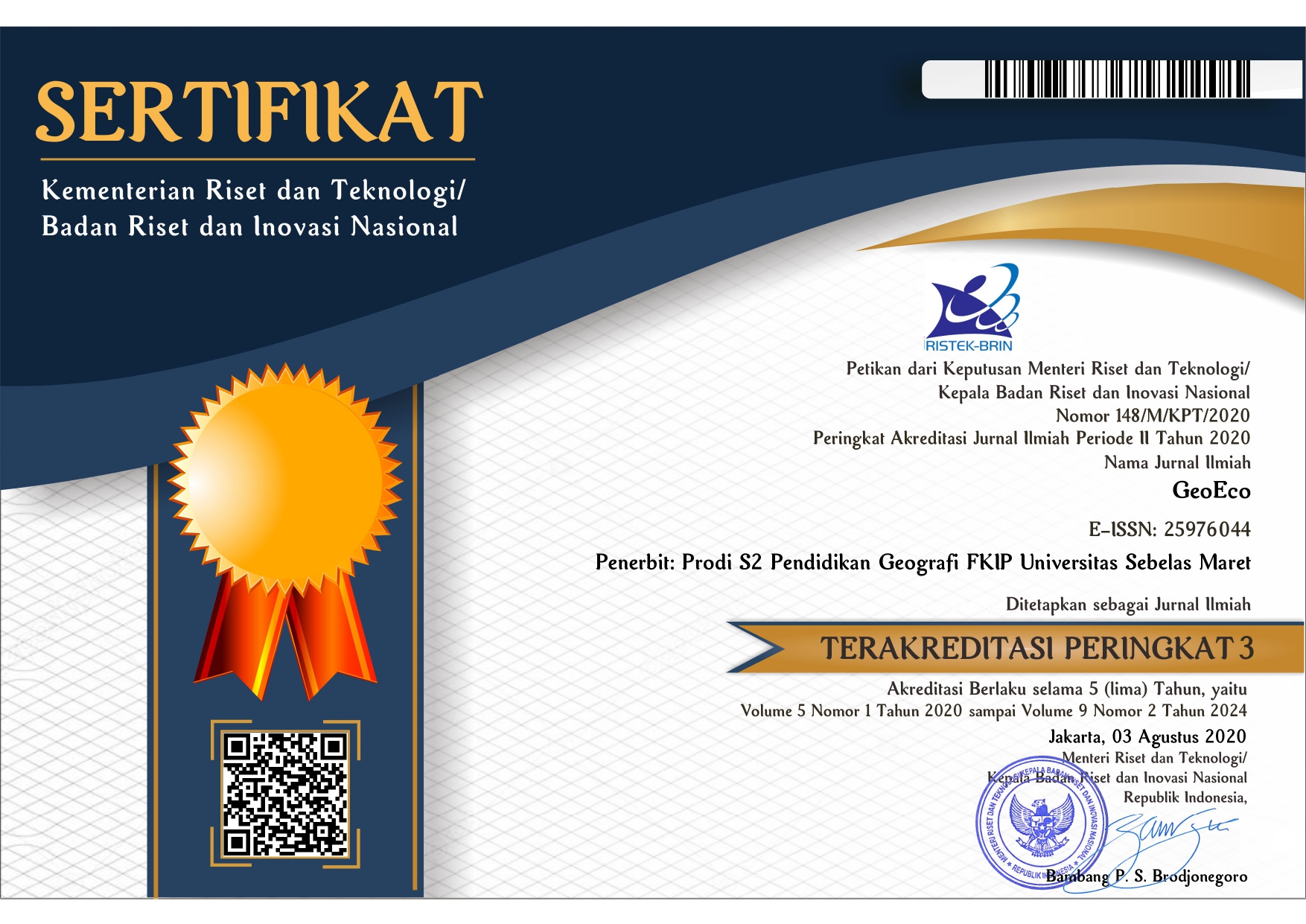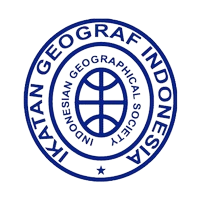FLOOD HAZARD MAPPING USING GIS SPATIAL ANALYSIS FUNCTIONS IN BALEENDAH, BANDUNG, WEST JAVA
Abstract
Keywords
Full Text:
PDFReferences
Alexander, M., Faulkner, H., Viavattene, C. and Priest, S. (2011). A GIS-based Flood Risk Assessment Tool; Supporting Flood Incident Management at the local scale. Proof of concept report to the Flood Risk Management Research Consortium (FRMRC2). BBWS Citarum Kementerian PU. (2011) Peta Informasi Citarum. Roadmap Coordination and Management Unit. Penanganan Banjir Sungai Citarum Hulu. Di Baldassarre, G., Schumann, G., Bates, P., Freer, J., and Beven, K. (2010b). Floodplain mapping: a critical discussion on deterministic and probabilistic approaches. Hydrol. Sci. J. 55 (3), 364-376. Diakakis, Μ., Mavroulis, S., and Deligiannakis, G. (2012). Floods in Greece, a statistical and spatial approach. Nat. Hazards 62, 485-500. Dodov, B.A. and Foufoula-Georgiou, E. (2006). Floodplain morphometry extraction from a high-resolution digital elevation model: a simple algorithm for regional analysis studies. IEEE Geosci. Remote Sens. Lett. 3 (3), 410-413. Downton, M.W. and Pielke, R. (2001). Discretion without accountability: politics, flood damage, and climate. Nat. Hazard. Rev. 2 (4), 157-166. European Commission (EC) “Directive 2007/60/EC of the European Parliament and of the Council of 23 October, 2007” on the assessment and management of flood risks, Official Journal of the European Union, L288/27-34: 2014. Forkuo, E. K., Asare, and Mensa, Y. (2012). River Inundation and Hazard Mapping – a Case Study of Susan River–Kumasi. Proceedings of Global Geospatial Conference, 14-17 May 2012, Quebec City, Canada. Nyarko, B.K., Diekkrüger, B., Van De Giesen, N. C., and Vlek, P.L.G. (2015). Floodplain wetland mapping in the White Volta River Basin of Ghana. GIScience and Remote Sensing. DOI: 10.1080/15481603.2015.1026555. Georgakakos, K.P. (2006). Analytical results for operational flash flood guidance. J. Hydrol. 317, 81-103. Kourgialas, N.N., Koubouris, G.C., Karatzas, G.P., and Metzidakis, I. (2016). Assessing water erosion in Mediterranean tree crops using geoinformatic techniques and field measurements; the effect of climate change. Nat. Hazards. Doi: http://dx.doi.org/10.1007/s11069-016-2354-5. Management Unit. (2011) Penanganan Banjir Sungai Citarum Hulu. Manfreda, S., Di Leo, M., and Sole, A. (2011). Detection of flood prone areas using digital elevation models. J. Hydrol. Eng. 16 (10), 781-790. Merz, B., Thieken, A.H., and Gocht, M. (2007). Flood Risk Mapping at the local Scale: Concepts and challenges. ResearchGate, Postdam, Germany: 2007, available at; http://www.researchgate.net/publication/226038430. Munich R. (2016). Natural catastrophes 2015. Annual figures. Munich Re NatCat Service. Available online:http://www.munichre.com/site/corporate/get/params_E1254966961_Dattachment/1130647/Munich-Re-Overview-Naturalcatastrophes-2015.pdf Nardi, F., Vivoni, E. R., and Grimaldi, S. (2006). Investigating a floodplain scaling relation using a hydrogeomorphic delineation method. Water Resources Research, 42(9). DOI: 10.1029/2005WR004155. Nyarko, B. K. (2000). Flood Risk Zoning of Ghana: Accra Experience. International Archives of Photogrammetry and Remote Sensing,Vol. XXXIII, Part B7. Amsterdam, The Netherlands. Nyarko, B.K. (2002). Application of a rational model in GIS for flood risk assessment in Accra. Journal of Spatial Hydrology, 1-12. Ologunorisa, T.E. and Abawua, M.J. (2005). Flood risk assessment: a review. J. Appl. Sci. Environ. Manag. 9 (1), 57-63. Pekel, J.F., Cottam, A., Gorelick, N., and Belward, A.S. (2016). High-resolution mapping of global surface water and its long-term changes. Nature 540, 418-422. Samela, C., Troy, T.J., and Manfreda, S. (2017). Geomorphic classifiers for flood-prone areas delineation for data-scarce environments. Adv. Water Resour. 102, 13-28. Schanze, J. (2006). Flood risk management a basic framework. Chapter 1 of Flood Risk Management – hazards, vulnerability and mitigation measures, NATO Science Series, IV Earth and Environmental Sciences, Vol. 67, Springer, Dordrecht, The Netherlands. UN-ISDR. (2009). Disaster Risk Reduction, Risk and Poverty in a Changing Climate: Invest today for a safer tomorrow. Global Assessment Report, assessment for disasters in urban areas, Fernerkundung and Naturkatastrophen. UNI-SDRR (2004). Living with Risk, a Global Review of Disaster Reduction Initiatives. United Nations Office for Disaster Risk Reduction (UNISDR). USGS (2011). Landsat Missions: Panchromatic Image Sharpening of Landsat 7 ETM+. 2011, available athttp://landsat.usgs.gov/panchromaticimagesharpening.php, last assessed 20/5/2015. Ward, P.J., Jongman, B., Salamon, P., Simpson, A., Bates, P., Groeve, T.D., Muis, S., Perez, E.C. de, Rudari, R., Trigg, M. A., and Winsemius, H.C. (2015). Usefulness and limitations of global flood risk models. Nat. Clim. Chang. 5 (8), 712-715. Ward, P.J., Jongman, B., Salamon, P., Winsemius, H.C., Aerts, J.C. J.H., Beek, L. P. H. van, Bierkens, M.F. P., Arno Bouwman, Kwadijk, J. C. J., Ligtvoet, W., Lucas, and Vuuren P.L., D.P. van (2016). Global drivers of future river flood risk. Nat. Clim. Chang. 6, 381-385. Wardhani, E. (2005). Analisa Deposisi Logam Berat Krom Dari Resuspensi Sedimen Sungai Citarum Hulu Dalam Skala Laboratorium. Tesis S-2. Program Studi Teknik Pengelolaan Lingkungan ITB. Bandung.
Refbacks
- There are currently no refbacks.












.png)

